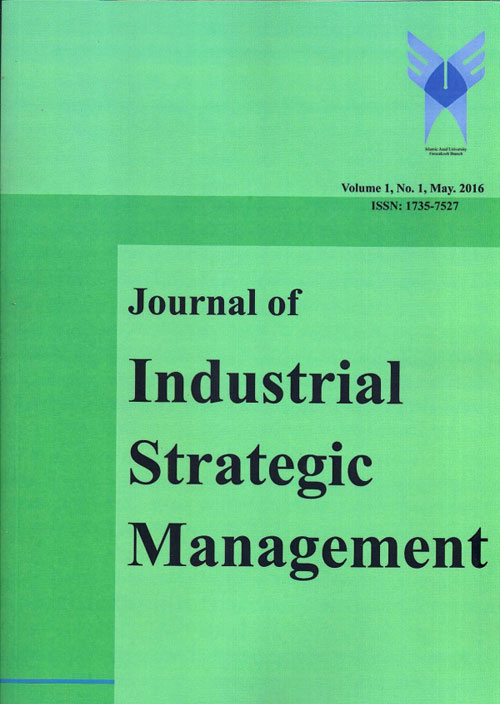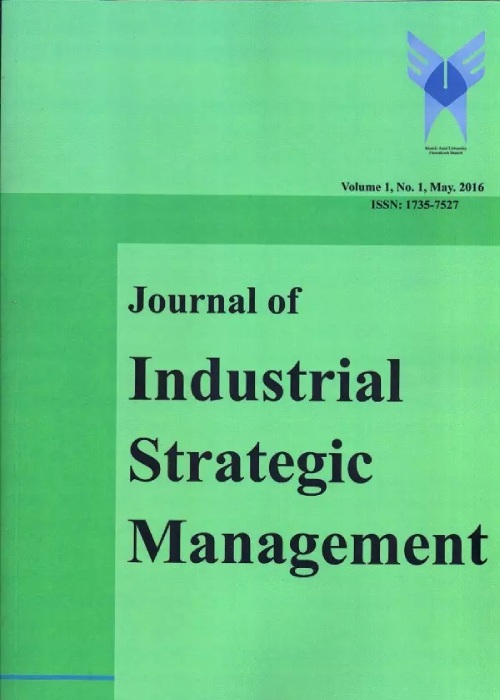فهرست مطالب

Journal of Industrial Strategic Management
Volume:6 Issue: 1, Winter 2021
- تاریخ انتشار: 1400/03/11
- تعداد عناوین: 6
-
Pages 1-13
Unforeseen events such as earthquakes, floods occur indifferent parts of the world or, like COVID-19 pandemic, affects the entire globally. The lack of proper preparation and confrontation with these accidents will cause heavy losses and damages to the nations which is sometimes irreparable. Humanitarian supply chains include all actors who are all on supposed to reduce the pain of the victims of the accident and are cooperating with each other to provide services to the victims of these accidents. The goal of a humanitarian supply chain,is not to make more profit, but saving the lives of mostly innocent people is preventing the crisis from escalating.Providing equipment, resources and facilities for relief operations and rescuing as well as meeting the needs of the victims is one of the most important issues in humanitarian action. Choosing right suppliers in the humanitarian supply chain is mainly based on two main criteria of “Technical Production Capability” and also “Response Support Capability” where the success factors in this chain focus on the agent environment, technology and organization. Obstacles to the implementation of the humanitarian supply chain are classified into five groups of “force barrier human”, “structural barriers”, “technological barriers”, cultural barriers” and “financial barriers”. In addition ,other issues such as the destruction of supply chain infrastructure like transportation infrastructure, warehouses storage of equipment and relief needs as a risk can also disrupt the humanitarian supply chain. Understanding such risks enables the humanitarian supply chain to be able to detect and deal with all unexpected events.
Keywords: Humanitarian, Supply Chain, resilience, COVID-19 -
Pages 14-31
Since work on dynamic aspects of balanced scorecards is just in an early state and a company may gain great insight from simulation results, this paper seeks to develop a dynamic model based on the financial perspective of a balanced scorecard (BSC) in a case study on the basis of a telecommunication company. The value of this paper, at first is related to the application of system dynamics (SD) in a BSC which overcome the limitations of BSC. At second, the paper provides causal loop diagram, dynamic modeling, simulation results, and validation results in the period 2015 to 2020 for the financial aspect to present suitable scenarios such as creation of new infrastructure, increasing the quality of services, diversification of product portfolio, and value-added services. At third, the paper is based on a case study of Tehran Telecommunication Company-Data Network which is a service-based company. Thus, it provides knowledge and information for academician and practitioners of BSC and SD to implement SD based on a BSC in companies, especially service-based firms.
Keywords: Financial perspective, Service-based Firms, Strategic Planning, Simulation -
Pages 32-41
The globalization of the economy and the development of information technology have led to the supply-oriented market to change to the demand-driven market and organizations to understand the necessity of meeting customer requirements to meet their survival. As the subject of the environment was connected to the economy and countries concluded that environmental protection can increase productivity, different attitudes have been taken to obtain these ideals, one of them is the green supply approach. Greening the supply chain needs new inputs that create chances for companies to invest in the design and production of greener products and meet sustainability requirements, and this includes not only consumer products, but also contains the inputs from suppliers that involve them in creating green markets. Despite the scope of green supply chain management, designing a green network is necessary. So, in this research, environmental considerations have been integrated with economic considerations, in which non-definitive conditions have been considered.
Keywords: Integrated Model, Multi-objective, Supply Chain, non-definitive -
Pages 42-57Background
An desirable supply chain can not be one-sided and not considering its various forms causes negative consequences and sometimes deviates from organizational purposes and considered goals in production; The output of this issue led to the formation of the general principle called larg supply chain management.
ObjectiveAccordingly, the present study was examined with the aim of identifying and prioritizing the factors affecting the establishment of long-term relationships with larg supply chain suppliers (lean, agile, resilient and green) with a fuzzy approach in medical equipment companies. Research
MethodThis study was applied in term of purpose and descriptive-survey studies in terms of research method in which, using theoretical and empirical foundations, each of the criteria has been determined in different dimensions of the larg supply chain. At first, using the fuzzy Delphi method, the main criteria and in accordance with the larg supply chain were determined. In the second step, these criteria were examined in supply chain companies using a one-sample t-test. In the next step, the determined criteria were prioritized using the opinions of 7 experts and the fuzzy hierarchical technique.
Keywords: relationships Lean chain, Agile chain, Resilient chain, Green chain -
Pages 58-61The purpose of this study is to identify the indicators affecting the improvement of the reverse supply chain in the home appliance industry in Tehran province. Preliminary indicators were obtained using theme analysis method and during in-depth and semi-structured interviews with 14 experts of the reverse supply chain in the home appliance industry in Tehran province. The final indicators of the research were identified using fuzzy Delphi method and A model for optimizing indicators in the form of objective function and constraints is presented. . In order to analyze the data, in the first place, with the help of ten experts, the final indicators were introduced and then, using the opinions of 36 people related to the issue of supply chain, the indicators were prioritized. The results of this study showed that the managerial dimension and consumer feedback , is a key factor in accepting new change and entering the issue of reverse supply chain. Knowledge dimension, including continuous improvement in the field of learning and education, etc., after management indicators and in the same initial stages, can be a determining criterion for improving the reverse supply chain in the industry. Finally, a model was designed using a model that shows the output of the status of indicators and using genetic algorithm (along with model testing in Gamz program) in MATLAB software, analysis was performed and the results were introduced by introducing optimal values and An improved model was presented.Keywords: Supply Chain, Reverse supply chain, Artificial Intelligence, Fuzzy Genetics Algorithm
-
Prioritization of effective factors on tax culture of Stan Kerman Tax Office with the combined method of GRA-VIKOR under fuzzy environmentPages 62-75
Tax culture is a collection of methods, insights, perceptions, social values and reactions and the amount of people's awareness of taxes and laws, the way they receive and cost it. The aim of this study was to identify and investigate the factors affecting the tax culture from the viewpoint of the work of taxation and the experts of Tax Administration in Kerman province. To determine the key factors affecting the tax culture by employing fuzzy Delphi approach. Then, prioritizing each of the key factors of tax culture in the organization of this study was achieved using the GRA-VIKOR hybrid method under fuzzy environment. The results indicate the high importance of three factors from eleven approved factors, respectively: 1) Justice and function of the tax affairs Organization, 2) advertising and informing the importance of paying taxes 3) transparent and simplified laws Tax on the tax culture in the society. Also, the results of sensitivity analysis indicate high validity of the proposed approach.
Keywords: Tax culture, the combined method of GRA-VIKOR, Delphi method, *sensitivity analysis


